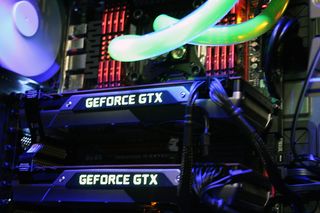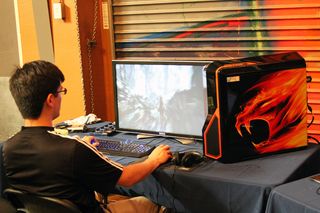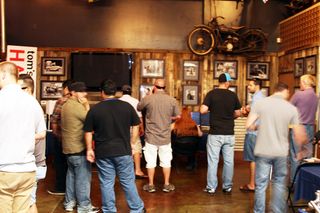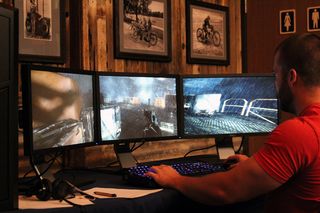Radeon HD 7990 Vs. GeForce GTX 690: The Crowd Picks A Winner
Tom's Hardware enlists the help of /r/Bakersfield, plus some of its Facebook community, to test AMD's Radeon HD 7990 with the latest Catalyst 13.8 beta driver against GeForce GTX 690. The all-day event turned up some interesting observations.
Getting Enthusiasts Together For A Day Of Benchmarking
Planning for our little experiment began shortly before AMD officially released the Catalyst 13.8 beta driver. I knew I wanted to get a group of local enthusiasts together to game on two identically-configured PCs. The experiment would have to involve multiple titles, and would consequently eat up most of a day if we wanted to collect a meaningful amount of data.
We started by building up the comparison machines. Gigabyte generously sent over two Z77X-UD5H motherboards, Osmium mechanical keyboards, and gaming mice. Rosewill contributed one black and one white Throne chassis, 1300 W Lightning power supplies, heatsets, and mouse pads. And Mushkin added matching 8 GB memory kits and 360 GB Chronos SSDs. We used Core i5-3570K CPUs overclocked to 4.2 GHz topped with Noctua NH-U12P heat sinks. Both systems received fresh Windows 8 installations with all of our games downloaded and updated in the hours prior to the event commencing.

We also lined up some exhibition hardware to keep everyone entertained as they waited for a turn on the two experimental setups. One of the systems we brought from the lab was a water-cooled Core i7-3970X-based system overclocked to 4.6 GHz with dual GeForce GTX Titans and a couple of SSDs in RAID 0. Special thanks to Swiftec for the water-cooling kit. We brought along our Nvidia Shield as well, and used the big machine to stream a handful of Steam-based games to the handheld.

Another box came from iBuyPower, which sent an AMD FX-9590-based machine with two Radeon HD 7970s in CrossFire.
The third demo we brought was shipped out by CyberPower. Its Zeus Hercules notebook, based on Clevo’s W740SU platform, gave everyone at the event their first experience with Intel’s Iris Pro 5200 on-die graphics, which was a nice treat.
With all of our hardware lined up, I called up the folks at Lengthwise Brewery, who allowed us use of their primary facility for the day. Perfect, right? Good food, craft beer, and technology.
Then, I jumped on /r/Bakersfield, let the local community know what was planned. I knew we’d only be able to accommodate a certain number of participants, given the complexity of our testing, so the idea was to spread everyone who could make it out over a few hours.
Stay on the Cutting Edge
Join the experts who read Tom's Hardware for the inside track on enthusiast PC tech news — and have for over 25 years. We'll send breaking news and in-depth reviews of CPUs, GPUs, AI, maker hardware and more straight to your inbox.

In reality, we had far more people come hang out than we could accommodate for testing. I had hoped to move fast enough that we could poll three pairs per hour. However, we ended up spending a lot more than two minutes per gamer, per system, per game in developing an opinion. Complicating matters, all of our equipment tripped breakers in the brewery, forcing us to do a little re-wiring.
And yet, everyone who was there demonstrated a level of patience that helped the whole event go as smoothly as it did (which I very much appreciated). We had enthusiasts drive up from LA, along with a representative from CyberPower, who made the trip with his family, but was still kind enough to answer questions from attendees about the Zeus Hercules and Iris Pro.

We split testing up into two phases. First, we compared GeForce GTX 690 to Radeon HD 7990 using three 1920x1080 displays in Surround and Eyefinity, respectively. AMD doesn’t yet support frame pacing in multi-monitor environments, so the results we generated did not reflect the feature’s influence. Then, we swapped out 5760x1080 for a single 30” screen at 2560x1600—the highest resolution we could test with frame pacing enabled.

Each participant was given a piece of paper with five game names written out and check-boxes for the two systems, allowing them to pick their favorite, along with a field to explain why they chose the experience they did. A favorite was not required—when both machines yielded equal results, the boxes were left unchecked. Because we had two machines, enthusiasts stepped up in pairs. We’d fire up one game, play through a specific sequence for a couple of minutes, switch chairs, choose the smoother system, and then repeat the process for the other four titles.
A very sincere thank-you to the Bakersfield sub-reddit, the folks who heard about the event on Facebook and drove to Bakersfield, Gigabyte, Rosewill, and Mushkin, Lengthwise Brewery, and the handful of gamers who participated in our first “GTX 690 vs. 7990” hands-on comparison, who volunteered to help setting up, tearing down, and taking pictures for this larger soiree.
Current page: Getting Enthusiasts Together For A Day Of Benchmarking
Prev Page Tom's Hardware Readers Rate Two Of The Most Expensive Graphics Cards Next Page Results: Battlefield 3-
iam2thecrowe can you please show cpu useage before and after the driver update, and also show results on a lower end system, like an fx6300 with dual 7850's? That would be interesting.Reply -
bin1127 A great article with some very interesting results.Reply
Chris really knows use funny and imaginative metaphors to start of his articles. Keep up the good work! -
iam2thecrowe can you please show cpu useage before and after the driver update, and also show results on a lower end system, like an fx6300 with dual 7850's? That would be interesting.Reply -
merikafyeah If I had $700 to spend on graphics, I'd buy the fastest single-gpu card there is:Reply
The Galaxy GeForce GTX 780 HOF Edition
http://www.hardocp.com/article/2013/08/14/galaxy_geforce_gtx_780_hof_edition_review/
http://www.amazon.com/dp/B00DZIFN4M/
Out of the box it beats the Titan in pretty much everything and when overclocked I'd bet performance would be indistinguishable from a GTX 690. And did I mention single GPU? Frame-pacing = non-issue. And those temps/noise ratios are in a league of their own. -
iam2thecrowe Reply11482712 said:If I had $700 to spend on graphics, I'd buy the fastest single-gpu card there is:
The Galaxy GeForce GTX 780 HOF Edition
http://www.hardocp.com/article/2013/08/14/galaxy_geforce_gtx_780_hof_edition_review/
http://www.amazon.com/dp/B00DZIFN4M/
Out of the box it beats the Titan in pretty much everything and when overclocked I'd bet performance would be indistinguishable from a GTX 690. And did I mention single GPU? Frame-pacing = non-issue. And those temps/noise ratios are in a league of their own.
you are pretty much right on there. people often overlook galaxy cards (i know i do), for obvious reasons (quality/after sales support) . but this card is insane, with extremely good OC capabilities. If i had a choice between this and a 690, i would certainly take this card. Althogh i would take 2 x of the cheapest 770's available before any of the mentioned cards. -
AndrewJacksonZA I think the most important part of this article is this little gem:Reply
"My wife is in the background with our then-two-week-old baby girl"
Congratulations Chris!!! :-) -
geok1ng With due respect for TH efforts on the subject, but keeping Metro LL results is a BIAS. How about some piecharts WITHOUT METRO LL?Reply -
Bill Reinhardt You know how wine is matched for optimal flavor compatability with certain foods?Reply
http://en.wikipedia.org/wiki/Wine_and_food_matching
You should have done that with beer and video games. -
Iron_Sean Why did you only test Triple monitors with no frame pacing versus single high res monitor with frame pacing?Reply
You're confounding variables and making your results hard to compare directly: Is the difference 6 MP vs 4 MP, frame pacing, or their crossfire/surround technology? This is an interesting idea, but I'd really like to see it narrowed to a single variable to better compare the technologies.
Most Popular


